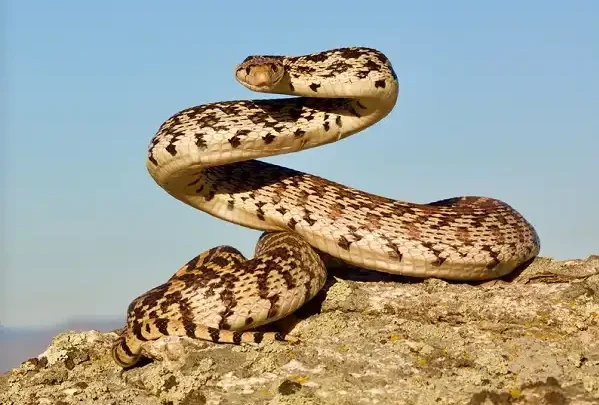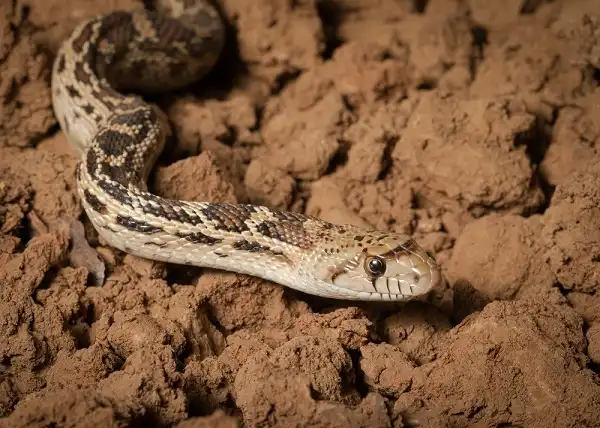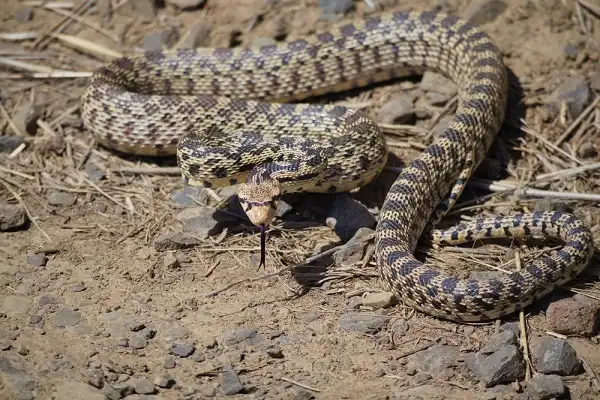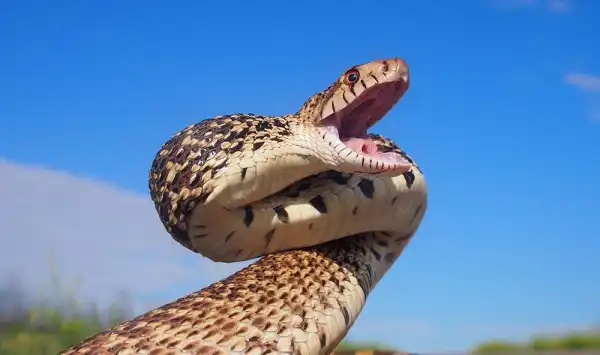Bullsnakes are fascinating creatures that are often misunderstood. These large, non-venomous snakes play an important role in the ecosystem, and yet they are often killed due to fear or misunderstanding. In this blog post, we’ll explore some of the interesting facts about bullsnakes and dispel some of the myths surrounding them. Hopefully, after reading this, you’ll have a new appreciation for these amazing animals!

Bullsnake Description
Bullsnakes are a species of large, non-venomous snakes that belong to the Colubridae family. They have yellowish-brown or grayish-brown skin with dark brown blotches along their back. The head is usually darker than the body and there may be some reddish coloring on the neck. They have stout bodies with large heads and small eyes that are usually black or dark brown in color. They have thick, elongated bodies and large triangular-shaped heads that can be identified by their dark brown or reddish coloration along the upper body. The lower portion of the body is usually light yellow or gray in color with a series of black spots running down either side. Bullsnakes may also have a distinctive pattern on their back consisting of various shades of gray, black, brown, and orange depending on the individual species.
Bullsnake Habitat
Bullsnake habitats can vary greatly depending on the surrounding geographic area. Generally, they tend to prefer grasslands, open fields, shrublands, and other dry areas of land. In the United States, they can be found in states such as Arizona, Colorado, Kansas, Nebraska, and New Mexico. They are also found in Canada, particularly in Alberta and Saskatchewan. Bullsnakes will establish burrows or tunnels underground near their food sources and are very good at digging deep crevasses with their powerful body strength. Since they are cold-blooded reptiles, they tend to stay close to the ground where it is warm enough for them to regulate their body temperature. Bullsnakes often use abandoned animal holes or existing burrows as shelter from extreme temperatures during winter months or when strong storms come through. In addition to these more traditional habitats, bullsnakes have been known to inhabit more urban areas in North America as well.
Bullsnake Diet
Bullsnakes are carnivores, meaning that they feed primarily on other animals. Their diet mainly consists of small rodents such as mice, rats, ground squirrels, and other small mammals. They will also feed on small birds and their eggs, lizards, frogs, and other reptiles that inhabit the same habitat. In addition to hunting for their own food in the wild, bullsnakes are also known to scavenge dead animals or livestock carcasses they come across while exploring their habitat. In some instances, they may even consume carrion from larger animals such as deer or antelope that have recently died due to natural causes or hunting activities conducted in their area. On rare occasions, bullsnakes may even eat insects or invertebrates if food sources become scarce during certain times of the year.

Bullsnake Size
Bullsnakes are a large species of snake that can range in length from 3 to 7 feet, with females typically being larger than males. Adult bullsnakes can weigh up to 15 pounds but their slender frames make them appear much lighter than they actually are. Additionally, bullsnakes have incredible strength for their size and can easily overpower prey items many times larger than themselves. Despite their impressive size and strength, however, bullsnakes remain docile creatures by nature and typically shy away from confrontations unless absolutely necessary; preferring instead to use camouflage or flee into burrows when threatened by predators or humans alike. While there are few natural predators capable of taking down an adult bullsnake due to its powerful defenses, young specimens may be vulnerable to attacks by birds such as hawks or eagles if they fail to reach adequate lengths before entering adulthood; thus making it essential that we protect these creatures’ habitats so future generations do not fall victim to endangerment due to absent conservation efforts.
Bullsnake Lifespan
Bullsnakes have an average lifespan of up to 18 years in the wild and can live up to 25 years in captivity with proper care. The oldest recorded bullsnake, however, reached a remarkable 31 years old; making it one of the longest-living snake species known to man. The life expectancy of a bullsnake depends largely on its habitat and climate as well as the availability of food sources. In areas where food is scarce or weather conditions are extreme, bullsnakes may not reach their full life span due to malnourishment or stress-induced illnesses.
Likewise, those living in highly populated regions may experience shortened lifespans due to increased threats from predators or humans alike. In captivity, however, these creatures can be provided with stable temperatures and diets that help extend their longevity compared to their wild counterparts. Captive snakes should also receive regular checkups from veterinarians experienced with exotic animals as this will allow for early detection of any diseases or abnormalities that may arise due to improper care or environmental settings.
Bullsnake Behavior
Bullsnakes are nocturnal animals, typically only coming out of their burrows and searching for food during the night. During the day, they are often found sunning themselves in order to regulate their body temperatures and remain active. As ambush predators, they rely on their camouflage colors to blend into their surroundings, allowing them to surprise unsuspecting prey as it moves past. In addition to hiding in plain sight, they also use chemicals secreted from special glands located near their mouths to hunt down prey by following scent trails. Although bullsnakes can be found alone most of the time, they have been known to gather in large numbers around dens when mating season begins; with males competing for access to females by displaying aggressive posturing and hissing.
Once a female has been courted successfully, she will lay anywhere up to 10 eggs that incubate over a period of 4-6 weeks before eventually hatching. When threatened or feeling cornered, bullsnakes will coil up in an attempt to make themselves appear bigger and more intimidating; however, this behavior is usually accompanied by loud hissing or tail vibrations meant to ward off any potential predators without having to resort to physical attack. They also possess sharp teeth which allow them to latch onto prey or opponents even when outside of striking distance; allowing them greater control over potential meals or enemies alike.

Bullsnake Speed
Bullsnakes are surprisingly fast creatures, capable of reaching speeds of up to 3 miles per hour. This is made possible by the incredibly strong muscles located in their bodies, which allow them to propel themselves through any terrain with ease. In addition to their speed, these animals also possess an impressive degree of agility which enables them to quickly change direction when necessary; proving useful when attempting to evade predators or locate food sources more efficiently. When hunting for prey, bullsnakes can move at an even faster rate thanks to the use of their tail as a makeshift rudder; allowing them to slither swiftly and silently towards unsuspecting meals without alerting potential opponents in the area. The length of these animals also works in their favor in this regard since they can cover larger distances with fewer movements; helping them outpace larger predators who tire easily or aren’t used to changing direction suddenly during chases.
Bullsnake Hunting
When it comes to hunting, bullsnakes possess an impressive set of skills that allow them to take down a wide variety of prey. They are adept hunters and will feed on anything from small insects up to rodents, lizards, other snakes, and even birds in some cases. The primary tactic used by bullsnakes when hunting is sneak attacks. These animals use their powerful muscles and agility to silently approach their target without detection; utilizing their camouflaged scales as additional cover while they close the distance between themselves and the unsuspecting prey. Once they are within striking distance, these predators launch out with lightning-fast speed using the bulk of their bodies to trap the victim in a tight grip. Once subdued, bullsnakes then use specialized venomous saliva to incapacitate their quarry before consuming it whole with their large jaws and muscular body structure. In some cases, these animals may also employ constriction techniques as well when facing larger or more aggressive prey items; relying on the strength of their coils in order to suffocate whatever stands in its way until exhaustion sets in and the meal can no longer resist its inevitable demise. In addition to their impressive physical capabilities, bullsnakes have also developed a keen sense for locating food sources as well.

Conclusion
Bullsnakes are some of the most impressive animals found in nature today. Their adaptations for hunting and locating prey, combined with their ability to regulate their body temperatures more effectively than other reptiles make them a formidable force in many ecosystems. Furthermore, their speed and agility help them traverse almost any terrain quickly and easily; making them one of the most versatile predators out there! Whether it’s using sneak attacks or taking advantage of scavenging opportunities, bullsnakes have mastered the art of survival in an ever-changing environment; providing us with a remarkable example of how evolution has shaped the world around us over time. With so much to learn from these amazing creatures, it’s no wonder why they are so highly revered by those who appreciate their remarkable abilities. It’s safe to say that the bullsnake is truly a marvel of nature!
Frequently Asked Question

